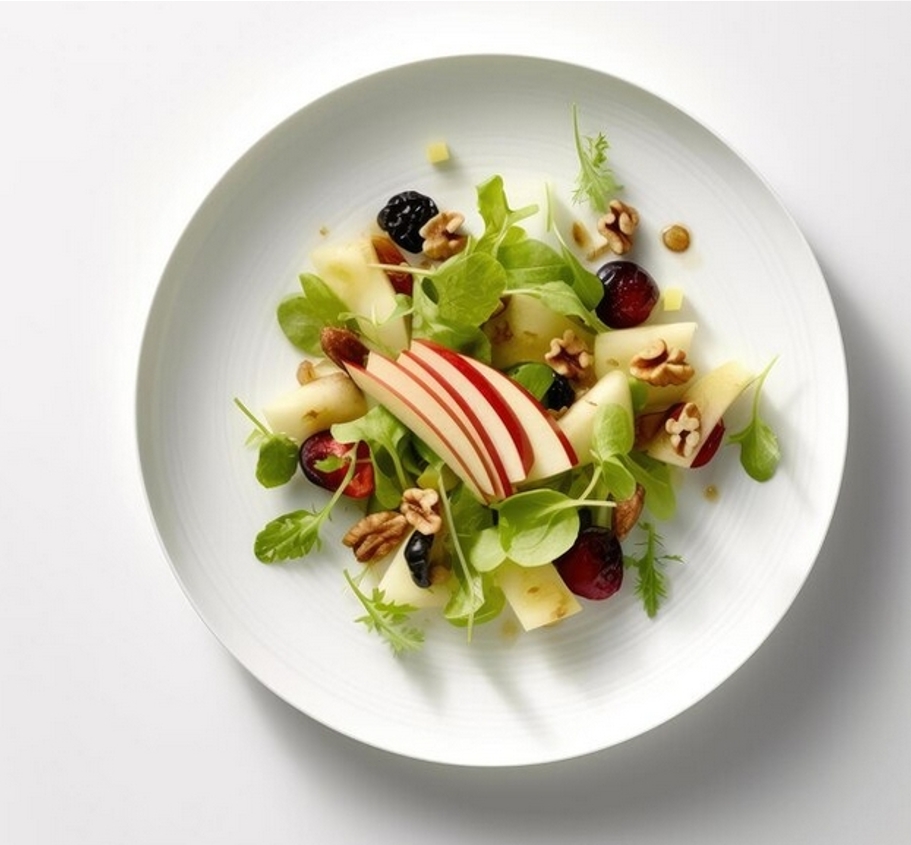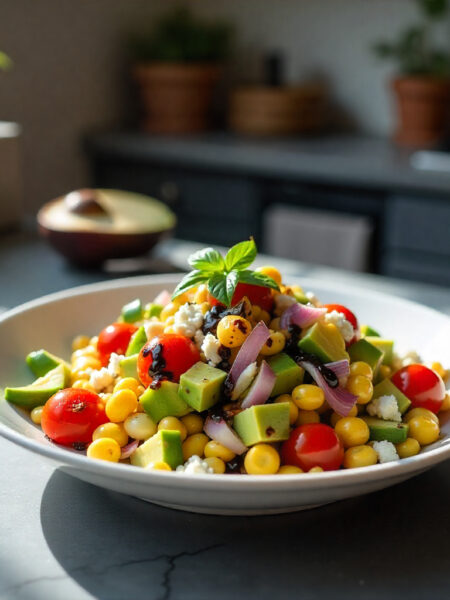Waldorf Salad
The Waldorf Salad: A Classic Blend of Simplicity, Elegance, and Flavor. Few salads have achieved the iconic status and enduring popularity of the Waldorf Salad. With its crisp apples, crunchy celery, sweet grapes, and rich walnuts bound together by a creamy dressing, the Waldorf Salad is more than just a dish—it’s a celebration of balance, refinement, and culinary history. Over a century old, this seemingly simple creation has managed to captivate palates across generations and continents, transcending its origins in a grand New York hotel to become a global favorite.
A Salad Born in Luxury
The Waldorf Salad owes its name and origin to the prestigious Waldorf-Astoria Hotel in New York City. The hotel, a symbol of luxury and grandeur at the turn of the 20th century, was the perfect birthplace for a dish that would blend both sophistication and accessibility. It was in 1896 that Oscar Tschirky, the maître d’hôtel of the original Waldorf Hotel (prior to its merger with the Astoria), introduced the salad to the hotel’s opening gala. Interestingly, Tschirky was not a chef by training, but he possessed a deep passion for food and an intuitive understanding of what would appeal to the upscale clientele.
At its inception, the Waldorf Salad was surprisingly minimalist—just apples, celery, and mayonnaise. The ingredients were straightforward, but their combination was revolutionary for the time. It was refreshing, crunchy, and creamy, offering a contrast of textures and a lightness that was uncommon in the heavier menus of the era.
Evolution Over Time
As with most classic dishes, the Waldorf Salad didn’t remain static. Over the decades, chefs and home cooks alike have adapted the original formula to suit changing tastes, regional ingredients, and dietary preferences. Perhaps the most significant and widely accepted addition to the original trio was walnuts. Their earthy crunch provided a new depth and texture that balanced the sweetness of the apples and the tang of the dressing.
Later versions often incorporated grapes, particularly red seedless ones, which introduced a burst of juicy sweetness and further enhanced the salad’s color palette. Some contemporary recipes also include raisins, yogurt instead of mayonnaise, or even proteins such as chicken or turkey to transform the salad into a complete meal.
The dressing, too, has seen variations—from the classic mayonnaise base to lighter blends using Greek yogurt, sour cream, or even citrus vinaigrettes. Each version adds a distinct personality while preserving the essence of the original: freshness, crunch, and a subtle creaminess.
A Symbol of American Culinary Heritage
What makes the Waldorf Salad truly fascinating is not just its flavor profile, but its role in American culinary heritage. It reflects a period in the United States when fine dining was emerging as a cultural marker, particularly in urban centers like New York. The Waldorf-Astoria was at the forefront of this movement, and the Waldorf Salad became a symbol of sophistication and class.
It has appeared on menus in various forms for over a century, a testament to its adaptability and appeal. From elegant luncheons to buffet tables, the Waldorf Salad has become a staple that bridges the gap between comfort food and fine dining.
Even beyond America, the salad has found its way into kitchens and restaurants around the world. Its ingredients are globally available and easy to substitute, making it a flexible dish that fits into many culinary traditions. Whether served in a French bistro or an Australian cafe, the Waldorf Salad maintains its timeless appeal.
Health and Nutrition Appeal
Another reason for the salad’s enduring popularity is its nutritional balance. Apples provide dietary fiber and antioxidants, celery contributes hydration and vitamins, and walnuts are rich in healthy fats, especially omega-3 fatty acids. When paired with a light dressing, the salad becomes a heart-healthy, low-sodium option that’s both satisfying and nutrient-dense.
This health-conscious appeal aligns well with modern dietary trends, especially among those seeking plant-forward or vegetarian dishes. Swapping mayonnaise for Greek yogurt or adding lean protein transforms the salad into a high-protein, low-carb meal, perfect for those following specific nutrition plans.
In recent years, the rise of clean eating and farm-to-table movements has brought renewed interest in dishes like the Waldorf Salad. Its reliance on fresh, raw ingredients makes it ideal for showcasing seasonal produce and local sourcing, aligning it with the values of sustainability and mindful eating.
A Canvas for Creativity
Perhaps one of the most underrated aspects of the Waldorf Salad is its versatility. While purists may stick to the classic components, adventurous cooks often view it as a blank canvas. Substituting pears for apples, adding pomegranate seeds for a tart twist, or using blue cheese for added richness are just a few of the many ways the Waldorf Salad has been reinvented.
Incorporating global influences has also expanded its range. A Middle Eastern spin might include tahini in the dressing and dried apricots in place of grapes, while a tropical version might feature mango or pineapple. Chefs experimenting with molecular gastronomy have even deconstructed the Waldorf Salad into foams, gels, and crisps—proving that even a 19th-century classic can find a home in 21st-century innovation.
Cultural References and Enduring Charm
The Waldorf Salad has also made its mark in pop culture. It was famously featured in the British comedy series Fawlty Towers, in an episode titled “Waldorf Salad” where an American guest’s demand for the salad leads to comic chaos in the hotel kitchen. This humorous depiction speaks to the salad’s iconic status—everyone seems to know what it is, even if they’ve never had it.
More than just a dish, the Waldorf Salad represents a moment in culinary time that continues to resonate. Its enduring popularity speaks to a broader truth: that the best recipes often come from humble beginnings, elevated by thoughtful preparation and a touch of history.
Conclusion: A Recipe Rooted in Elegance and Simplicity
At its heart, the Waldorf Salad is a lesson in simplicity done right. Each ingredient plays a role: the crisp sweetness of apples, the refreshing crunch of celery, the earthiness of walnuts, and the creamy tang of the dressing. It’s a dish that requires no cooking, yet delivers an extraordinary array of flavors and textures.
Whether enjoyed as a light appetizer, a side dish at a holiday meal, or a wholesome lunch, the Waldorf Salad remains a timeless classic. It invites creativity while honoring tradition, making it not only a culinary staple but a symbol of elegance, history, and good taste.
Waldorf Salad Recipe
Ingredients:
- 2 medium apples (Granny Smith or Gala), cored and chopped
- 1 cup red seedless grapes, halved
- 1 cup celery, thinly sliced
- 1/2 cup walnuts, roughly chopped and toasted
- 1/2 cup mayonnaise (or Greek yogurt for a lighter version)
- 1 tablespoon lemon juice
- Salt and pepper to taste
- Lettuce leaves, for serving (optional)
Instructions:
Prepare the Dressing:
In a medium bowl, whisk together the mayonnaise and lemon juice.
Season with a pinch of salt and pepper.
Toss the Salad:
In a large bowl, combine the chopped apples, grapes, celery, and walnuts.
Pour the dressing over the mixture and toss gently to coat everything evenly.
Chill (Optional):
For best flavor, cover and chill the salad in the refrigerator for 30 minutes before serving.
Serve:
Serve on a bed of lettuce leaves if desired.
Total Time:
- Prep: 15 minutes
- Chill (optional): 30 minutes
Total: 15–45 minutes
Servings: 4
Essential cooking tips for Waldorf Salad Recipe
1. Choose the Right Apples for Texture and Flavor
The foundation of a great Waldorf Salad is crisp, fresh apples. Choose varieties that balance sweetness and tartness, such as Granny Smith, Gala, or Honeycrisp. Granny Smith apples offer a tart crunch that holds up well in the creamy dressing, while Gala and Honeycrisp add a natural sweetness and juiciness. Avoid mealy or overly soft apples like Red Delicious, which can become mushy once mixed with the dressing. Cut the apples just before combining them with other ingredients to retain freshness and prevent browning, or toss them in a little lemon juice immediately after chopping to preserve their bright color and flavor.
2. Toast the Walnuts to Enhance Flavor and Crunch
Walnuts are a key ingredient in the Waldorf Salad, providing earthy richness and a satisfying crunch. However, raw walnuts can taste slightly bitter or bland. Toasting them brings out their natural oils and intensifies their nutty aroma and flavor. Simply place walnut pieces in a dry skillet over medium heat for 5–7 minutes, stirring occasionally, until they are golden brown and fragrant. Let them cool before adding to the salad. This small step adds a deeper, more complex layer to the salad and greatly improves the overall texture contrast.
3. Use a Balanced Dressing—Not Too Heavy, Not Too Thin
The dressing can make or break a Waldorf Salad. While traditional recipes call for mayonnaise, a good modern variation includes half mayonnaise and half Greek yogurt for a creamier, tangier, and healthier twist. The key is to maintain a dressing that’s rich enough to coat the ingredients without overwhelming them. If the dressing is too thick, it can make the salad feel heavy and clumpy. Too thin, and it can turn watery, especially after refrigeration. Whisk the dressing separately and season it lightly with salt, pepper, and a touch of lemon juice to brighten the flavor. Add just enough to coat the ingredients without drowning them—this keeps the salad fresh and appetizing.
4. Cut All Ingredients Uniformly for Even Texture and Presentation
The visual appeal and mouthfeel of Waldorf Salad are greatly enhanced when all components are cut to a similar size. Aim for small, even pieces—about 1/2 inch for apples and celery, and halve the grapes if they’re large. Uniformity ensures that each bite delivers a balanced mix of textures and flavors, from crunchy to creamy to juicy. It also helps the salad look tidy and elegant when served, which is especially important for entertaining or plating individually. Taking a few extra minutes to prep the ingredients neatly results in a salad that’s not only better tasting but also more visually appealing.
5. Chill the Salad Before Serving for Better Flavor Integration
Although Waldorf Salad can be served immediately after preparation, letting it chill for 30 minutes to an hour before serving allows the flavors to meld and the dressing to fully coat the ingredients. Chilling also enhances the crispness of the apples and celery while allowing the walnuts and grapes to absorb some of the dressing without losing their character. If you’re preparing the salad ahead of time, cover it tightly and store it in the refrigerator. Just before serving, give it a gentle stir and, if needed, add a small spoonful of fresh dressing to revive the creaminess. The result is a more cohesive, flavorful dish that feels refreshing and satisfying.
Important FAQs for the Waldorf Salad recipe
1. What are the key ingredients in a traditional Waldorf Salad?
A traditional Waldorf Salad consists of crisp apples, celery, and mayonnaise, often served on a bed of lettuce. Over time, walnuts and grapes were added, which are now widely accepted as standard. The apples provide a sweet and tart crunch, the celery adds freshness and texture, the grapes give juiciness, and the walnuts add an earthy depth. These ingredients are all bound together with a creamy dressing, making for a sweet-savory salad that’s both simple and elegant.
2. Can I use yogurt instead of mayonnaise in the dressing of Waldorf Salad ?
Yes, Greek yogurt is a popular alternative to mayonnaise in Waldorf Salad. It offers a lighter, tangier flavor and is lower in fat while still providing creaminess. You can substitute it entirely or do a half-and-half mix with mayo to balance richness with tang. Using yogurt also adds a protein boost and is ideal for those who prefer a healthier, probiotic-rich option. Just ensure the yogurt is thick (like Greek-style) to prevent the dressing from becoming too watery.
3. How do I prevent the apples from browning this recipe of Waldorf Salad?
To keep apples from browning after cutting, toss them in a small amount of lemon juice. The citric acid in lemon juice slows the oxidation process that causes apples to turn brown. This not only preserves the appearance of the salad but also enhances the flavor with a subtle brightness. If you’re prepping the salad in advance, you can also keep the apples submerged in cold water with lemon juice until you’re ready to mix the salad.
4. What apple varieties work best in Waldorf Salad?
The best apples for Waldorf Salad are those that are crisp and hold their shape, such as Granny Smith, Honeycrisp, or Gala. Granny Smith apples bring a tart contrast that pairs well with the creamy dressing, while Gala and Honeycrisp are sweeter and more aromatic. Avoid softer apples like Red Delicious, which tend to become mushy and lack the textural contrast essential to a good Waldorf Salad.
5. Can I make Waldorf Salad in advance?
Yes, you can make Waldorf Salad a few hours in advance, but it’s best served within 24 hours for peak freshness. Store it in an airtight container in the refrigerator. Keep in mind that apples and celery may lose some crispness over time, and the salad can become slightly watery. To avoid this, you can prep all ingredients ahead but wait to mix in the dressing until just before serving. A light refresh with a spoonful of dressing can revive its creamy consistency.
6. Is Waldorf Salad served as a side dish or a main course?
Traditionally, Waldorf Salad is served as a starter or side dish, particularly at luncheons, brunches, or holiday gatherings. However, you can easily turn it into a main course by adding protein such as grilled chicken, turkey breast, or even tofu. This transforms the dish into a light yet satisfying meal, perfect for warm weather or those seeking a protein-rich, low-carb option.
7. Can I make Waldorf Salad vegan or dairy-free?
Absolutely. To make a vegan Waldorf Salad, substitute mayonnaise with a plant-based mayo or use a cashew cream dressing. For a dairy-free version, simply avoid Greek yogurt and stick to vegan alternatives. You can also use maple syrup or agave if you want a hint of sweetness in the dressing. The rest of the ingredients—apples, celery, grapes, and walnuts—are naturally plant-based, making this salad very easy to adapt for various dietary needs.
8. What’s the best way to toast walnuts for the Waldorf Salad?
Toasting walnuts enhances their flavor and adds extra crunch. Place them in a dry skillet over medium heat, stirring frequently for about 5–7 minutes, or toast them in an oven at 350°F (175°C) for 8–10 minutes on a baking sheet. Watch carefully so they don’t burn, and let them cool before adding to the salad. Toasting brings out their nutty oils and reduces any bitter aftertaste, making the salad more flavorful overall.
9. Are there any creative variations of Waldorf Salad?
Yes, the Waldorf Salad is incredibly versatile and open to creative twists. Some variations include using pears instead of apples, adding pomegranate seeds for a tart pop, or incorporating blue cheese or goat cheese for extra richness. For a tropical spin, try adding pineapple chunks or mango. You can also swap out the dressing entirely for a vinaigrette if you prefer a lighter, zesty version. These customizations let you tailor the salad to seasonal ingredients or personal tastes.
10. What should I serve with Waldorf Salad?
Waldorf Salad pairs well with a variety of dishes. As a side, it complements grilled meats, roast chicken, or holiday turkey beautifully. Its freshness contrasts well with rich, savory main courses. As part of a light lunch, it works great alongside crackers, breadsticks, or a slice of quiche. It’s also a favorite at brunch tables and potlucks because of its refreshing, palate-cleansing qualities. The salad’s sweet-savory flavor makes it a versatile companion to many meals.
Waldorf Salad Recipe
At its heart, the Waldorf Salad is a lesson in simplicity done right. Each ingredient plays a role: the crisp sweetness of apples, the refreshing crunch of celery, the earthiness of walnuts, and the creamy tang of the dressing. It’s a dish that requires no cooking, yet delivers an extraordinary array of flavors and textures.
Ingredients:
Instructions:
Prepare the Dressing:
- In a medium bowl, whisk together the mayonnaise and lemon juice.
- Season with a pinch of salt and pepper.
Toss the Salad:
- In a large bowl, combine the chopped apples, grapes, celery, and walnuts.
- Pour the dressing over the mixture and toss gently to coat everything evenly.
Chill (Optional):
- For best flavor, cover and chill the salad in the refrigerator for 30 minutes before serving.
Serve:
- Serve on a bed of lettuce leaves if desired.






